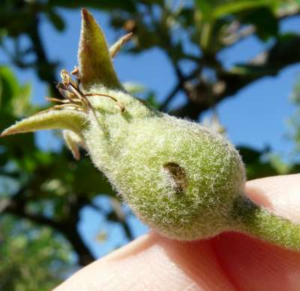Many vineyards are in bloom across Vermont, and inflorescence looks good and bodes well for a promising year. As I’ve been saying all along, be sure to maintain spray coverage for the next couple of weeks; to remove any diseased tissue as you find it; and to do your best to maintain an open canopy (more on that in a minute). All of the main diseases, including downy mildew, should be active now, so fungicide choice should cover all of the bases. That likely means applying a mix of materials that have multiple modes of action, like mancozeb (watch the 66-day preharvest interval) or captan and a strobilurin (Flint, Abound) or DMI (Rally, Elite, etc.). There are some good premix materials available that cover two modes of action, like Inspire Super and Pristine, but even they could use some protectant activity from mancozeb or captan to improve efficacy and reduce resistance development. The New England Small Fruit Management Guide has a good table that outlines the efficacy of the main fungicide materials available to growers. For organic growers, a rotation of sulfur and copper is pretty common now, but be sure to watch for signs of phytotoxicity. Coverage maintained for the next few weeks will pay off by allowing you to relax a bit for the second half of the summer.
Wild grape bloom occurred on June 19 in South Burlington, which sets the clock for grape berry moth management. The first overwintering generation is rarely significant enough to warrant a management spray except in vineyards that have had extreme damage in previous years. Each generation requires about 820 degree days (base 47°F, or DDb47°F) to complete, and the first generation typically emerges around the time of wild grape bloom. So if we use June 9 as our ‘biofix’ and track DDb47°F, we can estimate the best time to treat for the more damaging later generations.
This is made easy by the Network for Environment and Weather Applications (NEWA) system, which I coordinate for Vermont. The network includes twelve on-site weather stations (all located at orchards) and six airports, and imports data in near real-time for use in pest models. It is free to use, and growers can locate the site nearest them and develop a best-guess of phomopsis, black rot, and downy mildew infection periods as well as a sense of the grape berry moth generational development.
Plant tissue sampling is one of the best ways to plan fertility management in your vineyard, and now is one of the important times for collecting samples. Petiole samples may be collected at bloom or veraison, and comparisons between years or blocks should be based on the same time of collection. The benefit of a bloom sampling is that it gives you time to make corrections, if needed, during the present growing season.
Samples should be collected separately for each cultivar or block. In each sample, a random collection of 75-100 petioles should be collected from throughout the planting. Petioles should be collected from the most recent fully expanded leaf on the shoot, not across from the fruit cluster as is collected for a bloom sample. Just remove the whole leaf and snip the petiole (the leaf ‘stem’ off with your pruners. Gently wash each sample in water with a drop of dish detergent, then rinse fully and place in an open-top paper bag to dry. The closest analytical lab for grape petiole analysis that also provides pretty comprehensive management recommendations is the . There is a great section in Appendix A of the Wine Grape Production Guide for Eastern North America (which every grower should have a copy of on the bookshelf, ready to grab with short reach) which helps to guide fertilizer application rates based on soil and petiole samples. If you have a copy of those to send to me, I’d be happy to help you with the numbers as well.
Finally, I have two events to mention. First is a reminder of the July 9 Canopy Management Workshop we will hold at Ellison Estate Vineyard in Grand Isle. Please preregister here to attend.
The second is a UVM Horticulture Research & Education Center Research Open House that we will hold at the farm in South Burlington on August 6. Researchers with projects across the farm and working in multiple disciplines will showcase our work. I will host a tour of the research vineyard, and will have a pre-harvest management workshop at which we will discuss bird protection, late-season canopy and crop management, and preharvest sampling procedures to optimized juice quality at harvest. Watch for details on that event in the next week or so, but plan on it happening in the later afternoon around 3:00.
Where trade names or commercial products are used for identification,
no discrimination is intended and no endorsement is implied.
Always read the label before using any pesticide.
The label is the legal document for the product use.
Disregard any information in this message if it is in conflict with the
label.
The UVM Tree Fruit and Viticulture Program is supported by the
University of Vermont Agriculture Experiment Station, a USDA NIFA E-IPM
Grant, and USDA Risk Management Agency Funds.





